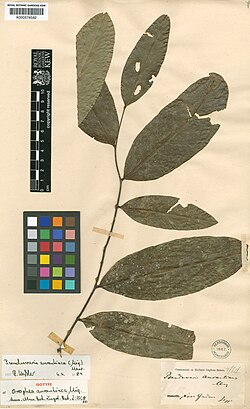Biology:Pseuduvaria aurantiaca
| Pseuduvaria aurantiaca | |
|---|---|

| |
| Herbarium specimen of Pseuduvaria aurantiaca.[1] | |
| Scientific classification | |
| Kingdom: | Plantae |
| Clade: | Tracheophytes |
| Clade: | Angiosperms |
| Clade: | Magnoliids |
| Order: | Magnoliales |
| Family: | Annonaceae |
| Genus: | Pseuduvaria |
| Species: | P. aurantiaca
|
| Binomial name | |
| Pseuduvaria aurantiaca (Miq.) Merr.
| |
| Synonyms | |
|
Orophea aurantiaca Miq. | |
Pseuduvaria aurantiaca is a species of plant in the family Annonaceae. It is endemic to New Guinea.[1] Friedrich Anton Wilhelm Miquel, the Dutch botanist who first formally described the species using the basionym Orophea aurantiaca, named it after its orange colored (aurantiacus, in Latin)[2] fruit.
Description
It is a tree that reaches 5 meters in height. Its branches have lenticels. Its leathery leaves are 14-19.5 by 5.5-7.5 centimeters and have pointed tips. The leaves are hairless when mature. The leaves have 12-18 pairs of secondary veins emanating from the central rib. Its petioles are 1.5-5 millimeters long with a groove on their upper side. Inflorescences are organized on slightly hairy peduncles 20-35 millimeters long. Each inflorescence consists of up to 10 flowers. Each flower is on a densely hairy pedicel 2-4 millimeters in length. The flowers are unisexual. Its flowers have 3 oval-shaped sepals, 0.8 by 1 millimeters, that have blunt tips. The outer surface of the sepals is densely hairy while the inside is smooth, and their margins have very fine hairs. Its 6 petals are arranged in two rows of 3. The outer petals are white or yellow-green and 2 by 2 millimeters. The outer petals are smooth on the inside and densely hairy on the outside. The inner petals have a 0.9 millimeter claw at their base and a 2-3.5 by 1.5-2 millimeter blade. The inner petals are smooth on their upper surface and densely hairy on their lower surface. Male flowers have up to 26 stamens that are 0.5-0.6 millimeters long. The gynoecium consists of 1-2 unfused carpels (monocarps). Fruit are attached to 30-40 millimeter peduncles by 8-9 millimeter pedicles. Mature monocarps are orange, hairy, wrinkly ellipsoids, 17-21 by 13-19 millimeters. Each monocarp has 6-8 wrinkly seeds, 8.5-13 by 6-8.5 millimeters.[3][4]
Reproductive biology
The pollen of P. aurantiaca is shed as permanent tetrads.[5]
References
- ↑ 1.0 1.1 "Pseuduvaria aurantiaca (Miq.) Merr.". The Trustees of the Royal Botanic Gardens, Kew. n.d.. https://powo.science.kew.org/taxon/urn:lsid:ipni.org:names:74937-1.
- ↑ Stearn, William (2004). Botanical Latin. Portland, Ore. Newton Abbot: Timber Press David & Charles. ISBN 9780881926279.
- ↑ Miquel, F.A.G. (1865). "Anonaceae Archipelagi indici". Annales Musei botanici lugduno-batavi 2: 1-45. https://www.biodiversitylibrary.org/item/2543.
- ↑ Su, Yvonne C.F.; Saunders, Richard M.K. (2006). Monograph of Pseuduvaria (Annonaceae). Systematic Botany Monographs. 79. American Society of Plant Taxonomists. p. 1-204.
- ↑ Su, Yvonne C. F.; Saunders, Richard M. K. (2003). "Pollen structure, tetrad cohesion and pollen-connecting threads in Pseuduvaria (Annonaceae)". Botanical Journal of the Linnean Society 143 (1): 69–78. doi:10.1046/j.1095-8339.2003.00204.x. ISSN 1095-8339.
External links
Wikidata ☰ {{{from}}} entry
 |

